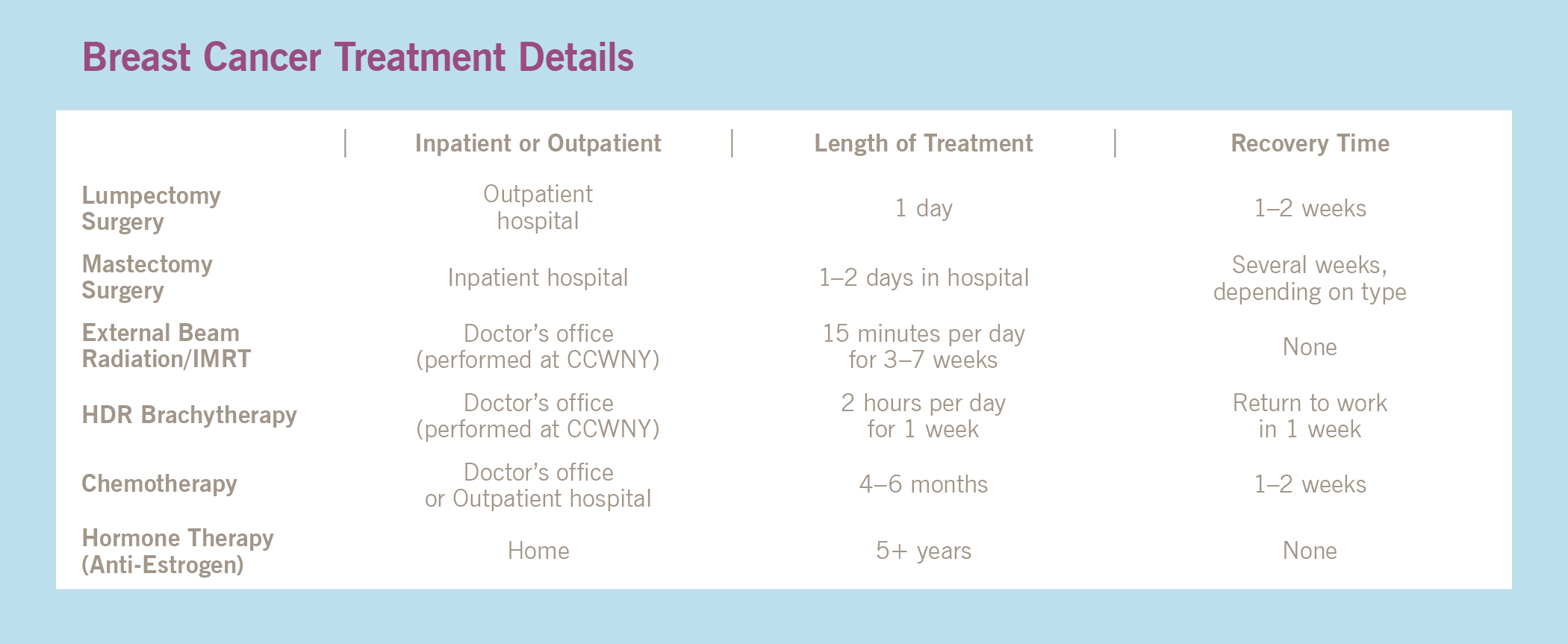Breast Cancer Treatment
Breast Cancer is the most common cancer in women. Breast cancer can occur in men, but is very rare. The good news is, many breast cancers can be cured. Cancer Care of Western New York offers advanced radiation treatment techniques that maximize your chance of being cured, while minimizing your risk of possible side effects.
We will work closely with your doctor, your surgeon, and other experienced specialists (including local obstetricians, gynecologists and medical oncologists) to develop an overall treatment plan that is best for you.
Our doctors have successfully treated hundreds of women with breast cancer. Now, we want to help you.
Click here to download our comprehensive breast cancer treatment brochure.
Signs and symptoms
Most breast cancers are discovered at an early stage. Click for more information on the risk factors and reducing the risk for breast cancer. Symptoms include:
- An abnormal mammogram
- A new lump in your breast or underarm
- Nipple discharge
- Pain in the nipple area
- Changes in the appearance of the nipple
- Changes in the skin of the breast, including thickening, swelling, irritation or dimpling
Screening and diagnosis
Breast cancer is often found through a mammogram, a breast examination by a physician, or a self-breast exam. If your physician thinks you may have breast cancer, you may be sent for ultrasonography, an MRI scan or a breast biopsy, which can offer a definitive diagnosis.
Breast cancer treatment options
Depending on the type and stage of your breast cancer you may have several treatment options. A summary chart of Treatment Details can be found below.

Surgical treatment
There are two main surgical techniques for breast cancer:
-
- Mastectomy a surgeon will remove your breast tissue down to the chest wall, including the nipple and area around the nipple.
- Lumpectomy a surgeon will only remove the abnormal area of tissue from your breast, along with some of the normal tissue that surrounds it.
Radiation therapy treatment
We are proud to offer the latest radiation treatment techniques. Our goal is to deliver a high dose of radiation to the specific area, without harming the surrounding healthy tissues. With state-of-the-art technology, we can maximize the destruction of cancer cells and your potential for a cure, while minimizing your risk of side effects and chance of a recurrence.
The first step is to develop a customized radiation treatment plan just for you. This plan will include one of the following two options. Neither option is painful, nor will either option make you radioactive:
Whole Breast Radiation This type of external beam radiation is used for patients who have had a lumpectomy; a similar technique is used for patients who require radiation after a mastectomy, to treat the chest wall and nearby lymph nodes.
-
- How it works—A machine sends radiation beams into your body to treat the entire breast, and (in some cases) the nearby lymph node chains. Whole breast radiation is safe, with limited side effects, which means you can usually keep up your daily activities.
- Treatment time—You will come in for approximately 10 minutes each day, Monday through Friday, for a total of three to seven weeks.
Partial breast radiation with High Dose Rate Brachytherapy (HDR) may be an option if you plan to have a lumpectomy. The benefit to partial breast radiation is that it may reduce your risk of side effects, and also has a shorter treatment time.
-
- How it works—Your surgeon will insert a small device in your breast with a small tube that will extend from the side of your breast. This device is easily removed in our office once your treatment sessions are complete.During each treatment session, the tube extending from your breast will be attached to a special high-dose-rate radiation (HDR) machine. This machine will put a radioactive seed into the device inside your breast for 10 or 15 minutes, then return it to the machine.
- Treatment time—Partial breast radiation treatments are delivered twice a day, for five days. Typically, there is a four- to six-hour break between the two daily treatments. You are free to leave the office during these breaks, and you should be able to go to work or do whatever you usually do during the day.
- Side effects—Treatment side effects may include a temporary skin reaction, fatigue, a small risk of infection, and a slight change in the size and shape of the breast (due to scar tissue formation).
Chemotherapy
Chemotherapy treatment with cancer-killing drugs that may be given intravenously (injected into a vein) or by mouth. There are several situations when chemotherapy may be recommended as part of your breast cancer treatment, including adjuvant chemotherapy (given to patients after surgery) and neoadjuvant chemotherapy (designed to shrink large cancers before surgery).
-
- Treatment time—Usually lasting for a few months, chemotherapy is given in cycles, with each period of treatment followed by a recovery period.
- Side effects—Possible side effects of chemotherapy include:
- Hair loss
- Mouth sores
- Loss of appetite
- Nausea and vomiting
- Increase of infections
- Easy bruising or bleeding
- Fatigue
These side effects are usually short-term, and go away after treatment is finished.
Continuing your care
Perhaps more than any other disease, breast cancer requires a team approach to help ensure the highest quality care. At Cancer Care of Western New York, we partner with leading providers throughout the region to make sure you and your family receive the information, treatment, and follow-up services to give you many productive and healthy years.
Some of the most common services include:
- Mammograms if you have had treatment for breast cancer, it is important to continue having mammograms of the affected breast, as well as the opposite breast.
- Ultrasounds usually used to target a specific area of concern found on the mammogram, this painless procedure helps distinguish between cysts (fluid-filled sacs) and solid masses, and between benign and cancerous tumors.
- Breast biopsies there are two main types of biopsies used to diagnose breast cancer: core needle biopsies and surgical biopsies.
- Sentinel lymph node biopsies an injection of a blue dye or a radioactive solution near the tumor or near the nipple, to help show which lymph nodes the cancer is most likely to spread.
- Genetic testing and counseling if you have a significant family history of breast cancer, you may want to learn about your cancer risk and decide if genetic testing is right for you.
- Massage can help reduce anxiety, and relieve some of the pain and discomfort you may be feeling as a result of your symptoms or treatment.
- Physical therapy can help you restore and maintain strength and range of motion in your muscles, particularly your shoulders; therapy can also be designed to prevent lymphedema (swelling of the arm).
- Lymphedema treatment reduces the swelling of the arm on the same side of the body as the affected breast; these treatments help keep the swelling from getting worse, and decrease the risk of infection.
For more information on Breast Cancer, click here to visit the American Cancer Society Breast Cancer page.
Osteoporosis
After fighting breast cancer, you may be predisposed to osteoporosis, but bone loss is not inevitable. Ask your doctor about potential preventive measures, including consuming enough calcium and vitamin D.
Contact Cancer Care of Western New York
If you have additional questions and need to schedule an exam, contact our oncology center today.
